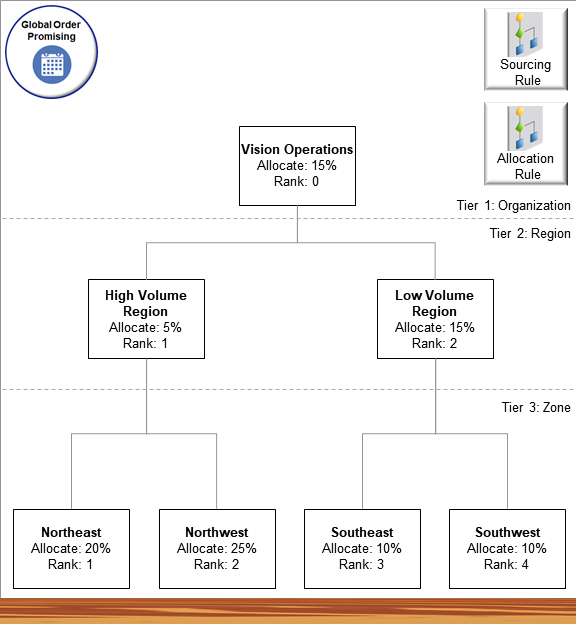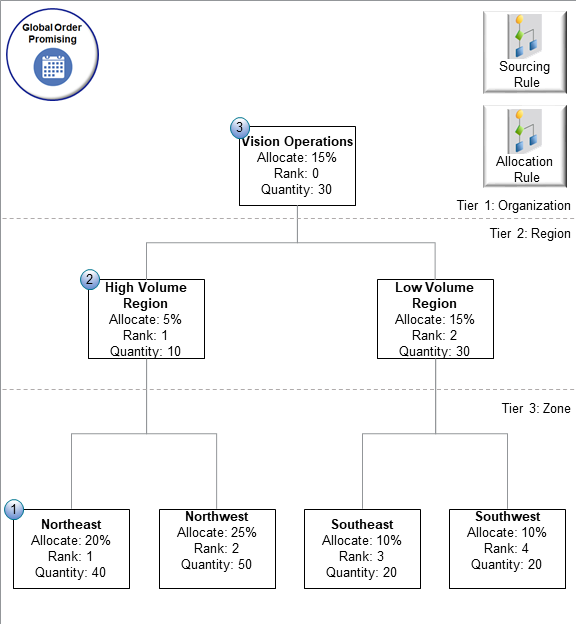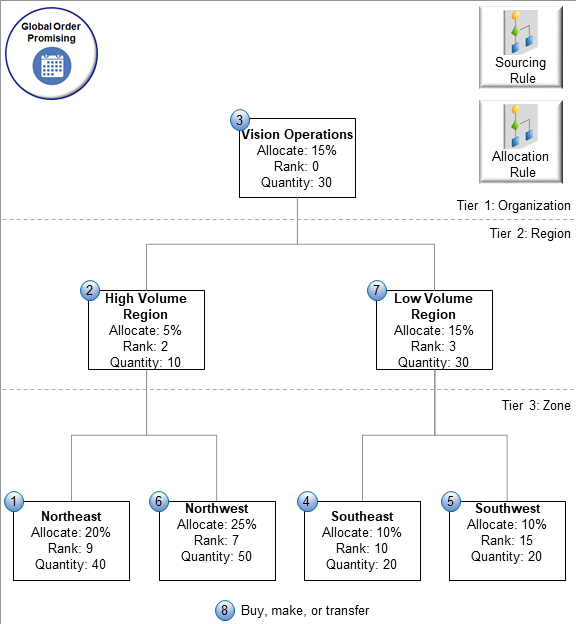Use Lower Priority Supply to Fulfill Higher Priority Demand
Set up your allocation rule so you can consume supply from a lower priority node to fulfill demand for a higher priority node.
If you have a node in your allocation hierarchy that's a lower priority than other nodes, and if you consume the supply that you have allocated to a higher priority node, then you can consume supply from the lower priority node instead delaying fulfillment for the higher priority node.
Assume you set up sourcing rules and allocation rules to create this hierarchy.

Note
- Vision Operations is the top parent of all the nodes. It contains two child nodes, High Volume and Low Volume.
- The High Volume node contains two child nodes, Northeast and Northwest.
- The Low Volume node contains two child nodes, Southeast and Southwest.
To set this up, do the same work that you do in Get Supply from a Node's Parent, except you add a rank for each node.
| Node | Allocation Percentage | Rank |
|---|---|---|
| Vision Operations | 15% | 0 |
| High Volume | 5% | 1 |
| Low Volume | 15% | 2 |
| Northeast | 20% | 1 |
| Northwest | 25% | 2 |
| Southeast | 10% | 3 |
| Southwest | 10% | 4 |
Don't Get Supply from Low Demand Nodes
Assume you have a total supply of 200 units.
- You set the Business Unit attribute on the order header to Vision Operations.
- You create an order line on that sales order and you set the Quantity on the line to 220.
Here's the sequence that Promising will use to allocate supply.

Promising will:
- Consume 40 units from the Northeast node for the week that starts on the Requested Date and from earlier weeks.
- Consume the quantity that's available to allocate from Northeast's immediate parent, which is 10 units from the High Volume node.
- Consume the quantity that's available to allocate from Northeast's grandparent, which is 30 units from the Vision Operations node.
- If Promising consumes all the allocation that's available in Northeast's parent hierarchy but still hasn't meet the order line's demand, then it uses transfer, buy, and make flows to search for other sources of supply.
- If Promising still needs more supply even after it searches through transfer, buy, and make flows, then it delays fulfillment for the sales order.
Here are the details.
| Node | Rank | Allocation Percentage | Quantity That's Available to Allocate |
|---|---|---|---|
|
Vision Operations
|
0 | 15% | 30 (15% of 200) |
| High Volume | 1 | 5% | 10 (5% of 200) |
| Low Volume | 2 | 15% | 30 (15% of 200) |
| Northeast | 1 | 20% | 40 (20% of 200) |
| Northwest | 2 | 25% | 50 (25% of 200) |
| Southeast | 3 | 10% | 20 (10% of 200) |
| Southwest | 4 | 10% | 20 (10% of 200) |
Note
- Promising aggregates the total supply over an allocation week.
- Promising allocates weekly supply to each node according to a percentage.
Get Supply from Low Demand Nodes
Continuing our example, assume you prefer to get supply from low demand nodes instead of from the parent nodes.

Here's the sequence that Promising will use to allocate supply.
| Step | Description | Remaining Balance |
|---|---|---|
| 1 | Consume 40 units from the Northeast node. | 220 minus 40 equals 180. |
| 2 | Consume the supply that's available to allocate from Northeast's immediate parent, High Volume, which is 10 units. | 180 minus 10 equals 170. |
| 3 |
Consume the supply that's available to allocate from Northeast's grandparent, Vision Operations, which is 30 units. If Promising consumes all the allocation that's available in Northeast's parent hierarchy but still hasn't meet the order line's demand, then proceed to the next step and get supply from a lower ranked node. |
170 minus 30 equals 140. |
| 4 |
Get supply from the node that has the lowest rank in the entire hierarchy, which is the Southwest Node at rank 15. Get the entire quantity that isn't protected, which is 20 units. If you had set protection for this node, say at 60%, then Promising would protect 12 units (60% of 20 is 12), and Promising would get only 8 units from this node (20 minus 12 equals 8). |
140 minus 20 120. |
| 5 | If getting Southwest's supply doesn't satisfy Northwest's demand, then get it from the node that has the next lowest rank, which is Southeast at rank 10. Get the entire quantity that isn't protected, which is 20 units. | 120 minus 20 equals 100. |
| 6 | If getting Southeast's supply doesn't satisfy demand, then get it from the next lowest rank, which is Northwest at rank 7. Northwest has a quantity of 50 that's available to allocate. | 100 minus 50 equals 50. |
| 7 | If getting Northwest's supply doesn't satisfy demand, then get it from the next lowest rank, which is the Low Volume Region at rank 7. Northwest has a quantity of 50 that's available to allocate. | 50 minus 30 equals 20. |
| 8 | You have traversed the entire supply hierarchy but still haven't fulfilled the order line, so Promising will use your sourcing rules and ATP rules to buy, make, or transfer the remaining 20 units that it needs to fulfill the order line. | 20 minus 20 equals 0. |
To set this up, do the same work that you do in Get Supply from a Node's Parent, except you add a rank for each node.
| Node | Allocation Percentage | Rank |
|---|---|---|
| Vision Operations | 15 | 0 |
| High Volume Region | 5 | 2 |
| Low Volume Region | 15 | 3 |
| Northeast | 20 | 9 |
| Northwest | 25 | 7 |
| Southeast | 10 | 10 |
| Southwest | 10 | 15 |